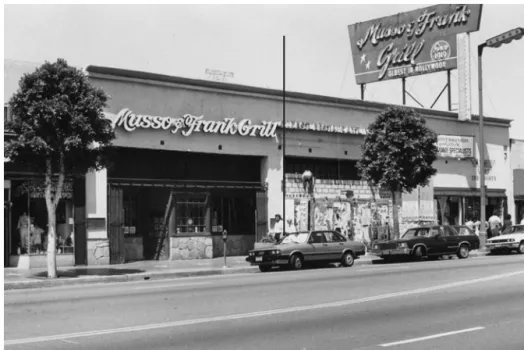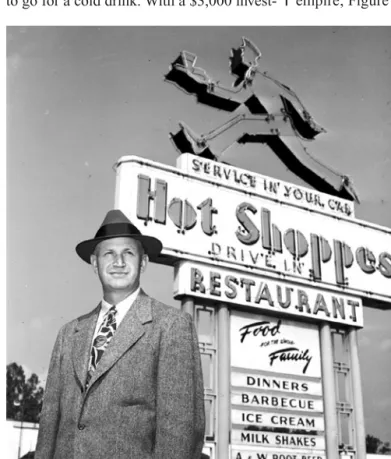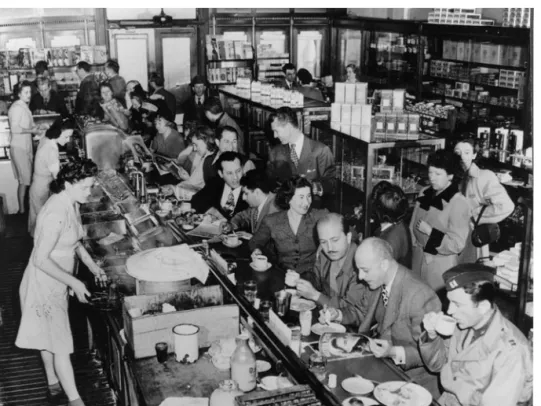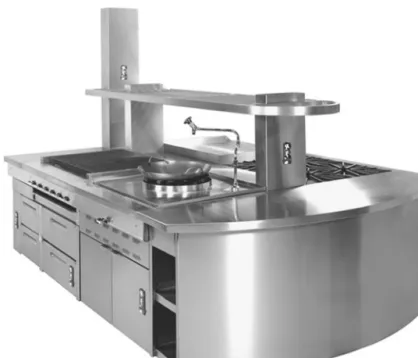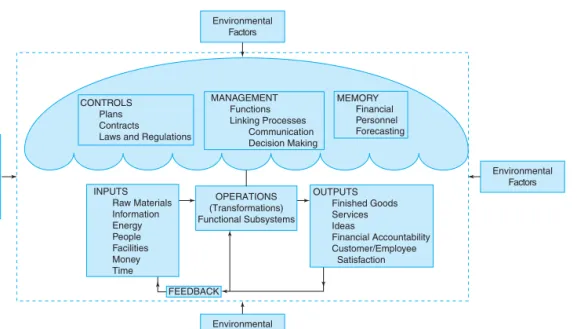Yuri Arcurs/Shutterstock; Chapter 11: Ariadna De Readl/Shutterstock; Chapter 12: Joe Sohm/Chromosome/Stock link; Chapter 13: Lateral Design/. Shutterstock; Chapter 14: Monkey Business Images/Shutterstock; Chapter 15: StockLife/Shutterstock; Chapter 16: Rod Ferris/Shutterstock; Chapter 17: Serhiy Kobyakov/Shutterstock; Chapter 18: Alexey Averiyanov/Shutterstock.
The Facilities 259
The Management Functions 355 CHAPTER 13 Organizational Design 357
Principles of TQM • The PDCA cycle • Six Sigma • Lean Six Sigma • TQM Tools Increasing productivity 446. Purpose of Accounting • Branches of Accounting • Uniform Accounting System • The Accounting Formula • Generally Accepted Accounting Principles.
PREFACE
NEW TO THE 12TH EDITION
Throughout the book
The latest performance improvement techniques including Six Sigma, Lean Six Sigma and the PDCA cycle. An in-depth look at the basics of accounting, including the purpose of accounting, branches of accounting, the unified accounting system, the accounting formula, and generally accepted accounting principles.
FEATURES
A glossary in the margins clearly defines and explains some of the key terms specific to this field of study. For example, the latest processing technology is discussed in chapters on food safety, purchasing and food service equipment.
ORGANIZATION OF THIS EDITION
COURSES FOR WHICH THIS TEXT IS SUITABLE
We hope that this revised edition of a classic text continues to meet the needs, as it has in the past, of the current generation of students preparing to become professional dietitians or food service managers. We also hope that faculty members will find Food Service Management: Principles and Practices, 12th Edition a useful guide and that food service managers will use it as a ready reference in their work.
ONLINE INSTRUCTOR’S RESOURCES
ACKNOWLEDGMENTS
PART I
The Foodservice Industry
The Systems Approach
CHAPTER 1
OUTLINE
CONSIDERED AMERICA’S FIRST FINE-DINING RESTAURANT,
The timeline is not intended to be exhaustive, but rather to provide highlights of the most critical events in the long history of hospitality. Each of the four types of food service operating systems found in the United States today is described with its characteristics, advantages, and disadvantages.
Pocket Factbook
Employment
Restaurants by the Numbers
Restaurant Sales
The information in the following chapters is the basis for the successful operation of all types of food services, regardless of their philosophies and objectives. In Part 1, the scene is set by providing the reader with an overview of the history of the foodservice industry and its current status, followed by a discussion of trends, systems approaches, and the different types of foodservice production systems in use. today.
KEY CONCEPTS
Despite the many types of catering services operating in the United States today, it is important to emphasize the fact that they are more similar than different. The fundamental aspects of food service management are presented in Part 2, including the critically important topics of food safety, hazard analysis and critical control points (HACCP), cleaning, sanitation, safety and dining.
THE HISTORY OF FOODSERVICE
A FOODSERVICE INDUSTRY TIMELINE 5th Century
In the castle kitchen, the chef and his staff turn meat (pork, beef, mutton, poultry or game) on a spit and prepare stews and soups in large iron cauldrons suspended over the fire on a hook. The pastry chef and the butcher are not rated as highly, but they are appreciated for their contributions.
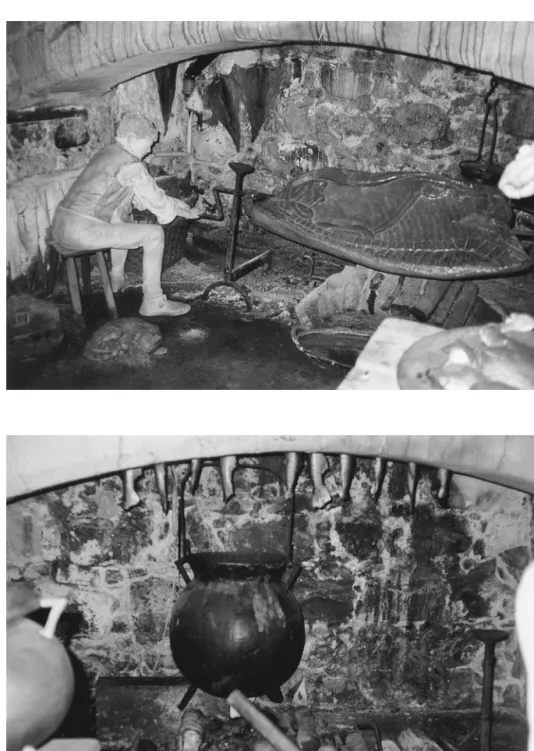
12th Century
14th Century
17th Century 10th Century
16th Century
New York Fraunces Tavern opened on the corner of Pearl and Broad Streets where it still operates. France The first star chef, Antonin Careme, cooks for Tsar Alexander of Russia, King George IV of England, Talleyrand of France, and others.
Early 19th Century
New York The Delmonico Hotel opens as the first major hotel in the United States to operate on the European plan (the room and meals are priced separately). New York A brand new 8-story Delmonico's opens, with electric lights for the first time.
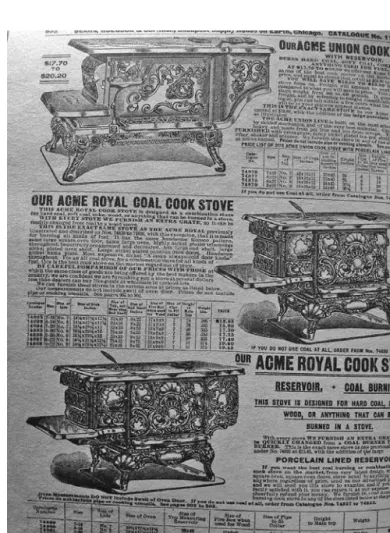
20th Century
United States The soda counter in the pharmacy (Figure 1.15) and the coffee shop become "in" places. United States Economic recession is good and bad for the restaurant industry.
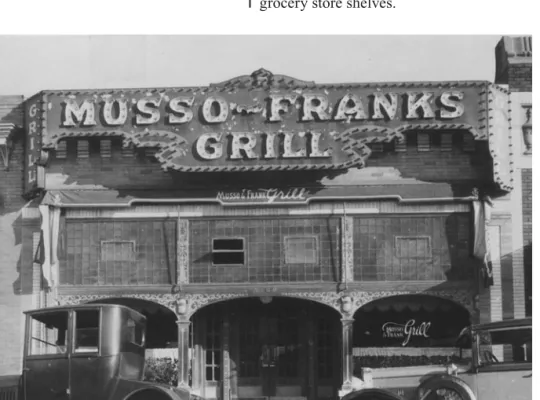
April 23–July 11, 1985
Meal deductions are reduced to 80 percent from 100 percent, the FICA tax-on-tips mandate is in place, and the Americans with Disabilities Act and Family Leave Bill go into effect.
Late 1980s
21st Century
Some Jack in the Box restaurants have the information framed on the wall near the counter. California Pizza Kitchen had calorie counts on the menu, but removed them when customers complained.

SUMMARY
APPLICATION OF CHAPTER CONCEPTS
CRITICAL-THINKING QUESTIONS
CHAPTER REVIEW QUESTIONS
What sciences led to improvements in the methods used in food service in the country and what were these changes. What are the socio-economic and political conditions and demographic changes that have affected the food service industry in the past and what is the impact they currently have today.
SELECTED WEB SITES
CHAPTER 2
WHEREAS THE FIRST CHAPTER FOCUSES ON THE HISTORY
9. The four main types of food service operations that exist today are conventional, ready-to-eat, commissary, and assembly/serve. Each of the four types of food service operating systems found in the United States today is described with its identifying features, advantages, and disadvantages.
STATUS OF FOODSERVICE TODAY
FACTORS AFFECTING GROWTH
An increase in the Asian and Hispanic populations, in which “married with chil- dren” units make up more than one-third of households, has led to a decrease in the
The awakened interest in the health and well-being of people and concern about improving the nutritional status of individuals has also had an impact on foodser-
The shortage of qualified foodservice personnel is an internal factor that is having an impact on the industry. If the labor crisis continues, it may affect the foodservice
TRENDS IN FOODSERVICE
Locally produced wine and beer—combined with culinary/savory cocktails and artisan liquor
The correctional food service is expanding rapidly as the prison population grows and the use of the cooking/refrigeration method continues to increase (Figure 2.1). Some estimate that by 2025, half of the prison population will be over 50.
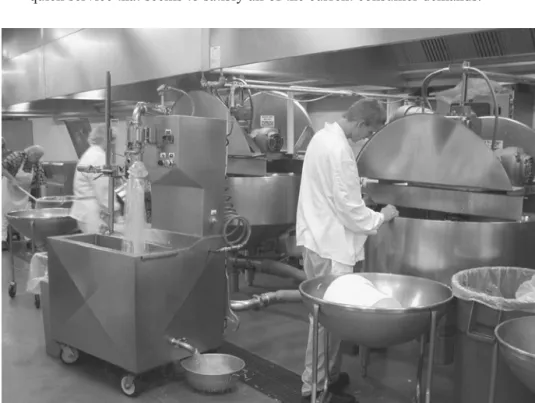
CHALLENGES FACING THE INDUSTRY
CLASSIFICATION OF FOODSERVICES
The term service scope in foodservice operations refers to the number and types of business units offered through individual foodservice operations. There is a commonality among them that can be identified for the purpose of grouping them into specific types of foodservice operations.
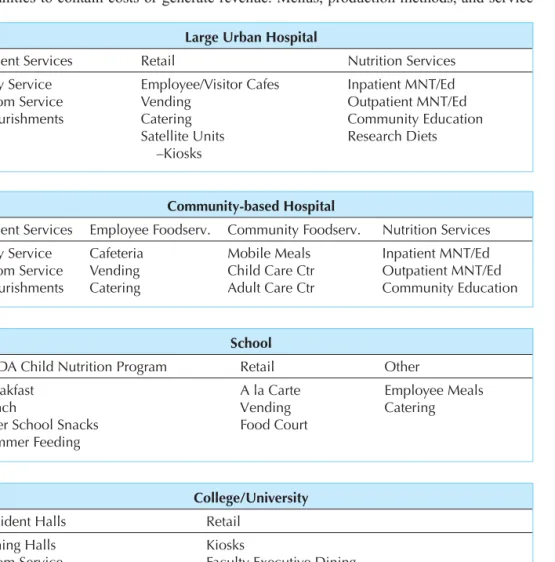
FOODSERVICE OPERATIONS
Finally, the food manager must understand the needs of each unit to allocate limited resources effectively among units during the budget planning process. Also, within each of these groups, there are many types of food service establishments; each of these institutions has its own objectives, goals and type of organization and management.
THE SYSTEMS CONCEPT AND APPROACH
Decisions are made in light of the overall effect of management on the organization as a Dynamic Equilibrium. The outputs must be aligned with the mission, goals and objectives of the organization.
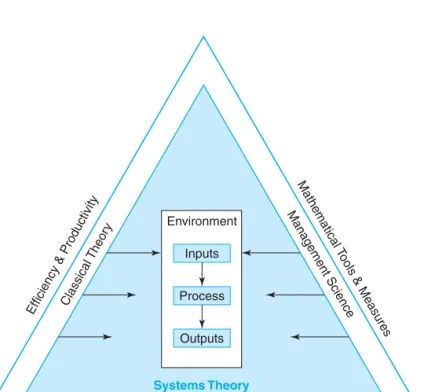
TYPES OF FOODSERVICE SYSTEMS
- PART 2
- Food Safety
- Facility Sanitation and Worker Safety
- The Menu
- CHAPTER 3
KEY CONCEPT: Each of the four major types of food service operations has distinct advantages and disadvantages. A summary of the main characteristics of each system is given in Table 2.1 (see pages 58 and 59).
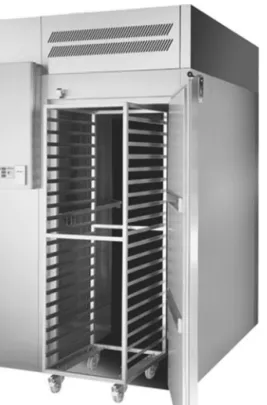
GUESTS OF ANY EATING ESTABLISHMENT HAVE CERTAIN
7. Well-designed and measurable prerequisite programs serve as the foundation of an integrated food security program. 8. The single most important prerequisite for an effective food safety program is personal hygiene.
FOODBORNE ILLNESS
A systematic and science-based approach to food safety programming and inspection that focuses on the identification and control of hazards that have the potential to cause foodborne illness. 6. A matrix of food laws, regulations, codes and standards provides the legal framework for food safety programming.
Scope of the Problem: Incidence of Foodborne Illness
The CDC estimates that there are 48 million cases of foodborne illness in the United States each year. Underreporting and underestimation of true incidence is a reflection of the complexity of foodborne illness.

Costs Associated with Outbreaks of Foodborne Illness
Two federal bills have been introduced as a result of this group's work and are currently making their way through Congress. Together, these bills have far-reaching implications for all aspects of the food industry (including food service).
THE ROLE OF THE FOOD MANAGER
On March 14, 2009, President Obama announced the formation of the Food Safety Working Group, a group specifically mandated to advise the President on food safety issues and how to correct them. The House and Senate of the 111th Congress finalized the Food Safety Modernization Act when the session ended in December 2010.
CAUSES OF FOODBORNE ILLNESS
Hazards Inherent to Food
The following is a summary of some of the most important pathogens that can cause foodborne illness. Primary organisms that cause foodborne infections include, but are not limited to, salmonella, Campylobacter jejuni, pathogenic Escherichia coli, and Listeria monocytogenes. The first two are particularly common and require special care in food handling.
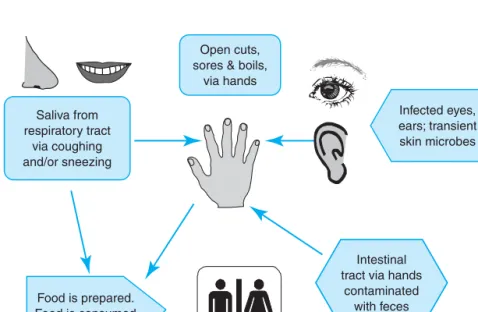
Hazards Introduced to Food by People and Practices
A SYSTEMS APPROACH TO FOOD SAFETY
Controls and Food Safety
Regulations and standards established by law and enforced by various agencies should serve as the minimum standards for food safety practices. The code promotes HACCP as the best available system for ensuring food safety.
FOOD SAFETY: AN INTEGRATED PROGRAM OF HACCP AND PREREQUISITE PROGRAMS
KEY CONCEPT: A matrix of food laws, regulations, codes and standards provides the legal framework for food safety programming. KEY CONCEPT: Well-designed and quantifiable prerequisite programs serve as the foundation of an integrated food safety program.
Prerequisite Programs: The Foundation of an Integrated Food Safety Program
The first classification of hazards is referred to as inherent hazards (eg a hazard specific to the food) and would include, for example, salmonella on eggs. Methods to control the second group of hazards require prerequisite programs and standard operating procedures (SOPs).
Prerequisite Programs and Standard Operating Procedures (SOPs)
There are also the dangers introduced in or on the food materials in the food service itself. The second group of hazards represents environmental hazards and includes procedural errors, such as cross-contamination from equipment that has not been properly cleaned and disinfected.
EMPLOYEE HEALTH AND PERSONAL HYGIENE
The successful hiring process must be followed by a thorough orientation and training on the personal hygiene standards established for food service operations. Policies covering appropriate dress, personal hygiene habits and employee illnesses should be developed, implemented and monitored.
Proper Attire
There are preventive measures that the manager can implement from the hiring stage to reduce the risk of food contamination and mishandling.
Personal Hygiene Habits
Smoking should only be allowed in designated areas and not near food preparation and service areas (preferably outdoors). All cuts and abrasions, such as burns and boils, should be covered with a waterproof bandage.
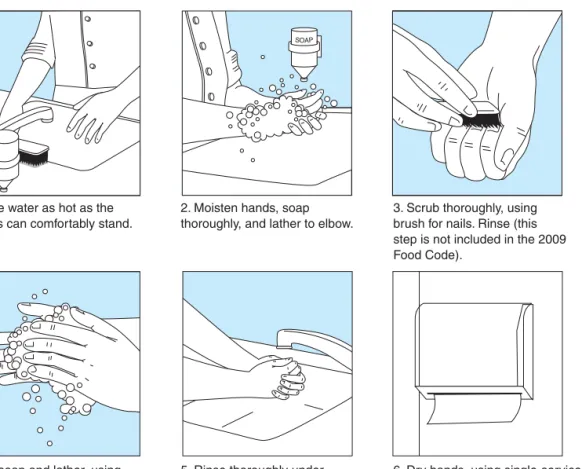
FLOW OF FOOD THROUGH THE FOODSERVICE OPERATION
Proper Food Handling
The Food Code recommends that the total time in the danger zone be limited to 4 hours for any food product. Thermometers should be used to check incoming deliveries of chilled foods and to monitor internal temperatures at all stages of storage, production, storage and service.
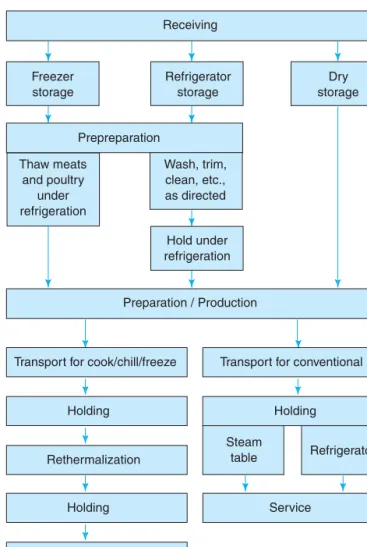
Potential Hazards in Food Production
Regardless of the method used, the internal food temperature should be reduced to 70°F within the first 2 hours; then to 41°F within the next 4 hours. To cool quickly, the food should be divided into shallow containers to a depth of no more than two inches and refrigerated, as shown in Figure 3-10.
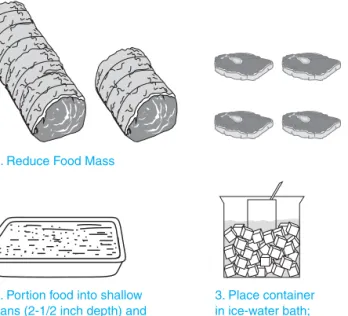
HAZARD ANALYSIS AND CRITICAL CONTROL POINT
Establish critical limits for preventive measures associated with each identi- fied CCP: For example, time and end-point cooking temperatures should be established
Establish the corrective action to be taken when monitoring shows that a critical limit has been exceeded: For example, if a minimum end-point temperature is not met,
Establish effective record-keeping systems that document the HACCP system
Documentation requirements are achieved through existing records, including receipt records, storage temperature charts, standardized recipes, and service records (see, e.g., the time-temperature documentation sheet shown in Figure 3.13). Receipt, storage and preparation are seen as individual HACCP plans because the identified hazards, CCPs, critical limits and monitoring procedures are similar for all ingredients, regardless of the recipes in which they are used (see, e.g., the plan HACCP for receiving shown in figure 3.15).

MANAGING AN INTEGRATED FOOD SAFETY PROGRAM
Bake for 1 hour at 350°F to a minimum internal temperature of 165°F and until the product is firm in the center (do not overbake). If the internal temperature of scrambled eggs is less than 165°F, continue baking until the internal temperature is at least 165°F and is held for 15 seconds.
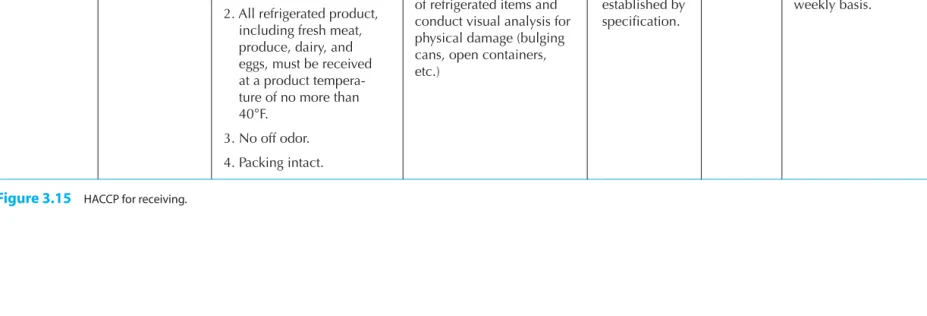
ENFORCEMENT: THE REGULATORY INSPECTION
Good hygiene practices 4 IN OUT N/O Proper eating, tasting, drinking, 5 IN OUT N/O No discharge from eyes, nose and mouth. 14 IN OUT N/A Food contact surfaces: cleaned and disinfected 15 IN OUT Correct disposal of returned, previously.
APPLICATION OF CHAPTER CONTENTS
It is the food manager's responsibility to have the necessary knowledge base and an understanding of food handling principles to design, implement and monitor a successful food safety program.
PROVIDING A CLEAN, SAFE FOODSERVICE FACILITY IS
The purpose of this chapter is to review the principles of cleaning and sanitation as they relate to warehouse washing and facility maintenance. The chapter concludes with guidance on how to design, implement and monitor a prerequisite cleaning and sanitation program.
CLEANING AND SANITATION
Principles of Cleaning
Water alone has some cleaning value, but more often it serves as the carrier of the cleaning agent for the dirty surface. There are a number of these products to choose from and they vary depending on the specific purpose of the product.
Principles of Sanitation
These products must be used carefully to avoid damaging the surface to be cleaned. KEY CONCEPT: Type and usage are indicators of how and when to clean a device.
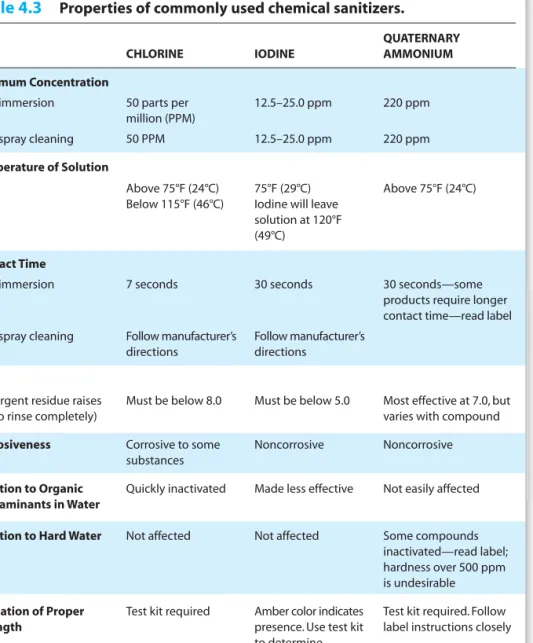
DISHWASHING
The third category is manual cleaning, which requires complete disassembly for cleaning and performance inspection.
Production Utensils
A recommended method is by immersing them for at least one minute in a lukewarm (at least 75°F) chlorine bath containing at least fifty parts per million (ppm) available chlorine. Dishes and utensils must be thoroughly clean for a chlorine rinse to be an effective bacteria-killing treatment.
Dishes, Glassware, and Silverware
To prevent water stains, it is advisable to use a suitable detergent for washing silver and also a drying agent with high wetting properties in the final rinse water to facilitate air drying. In the small, hand-operated, single-tank machines, the process and length of washing time is under the control of the operator and.
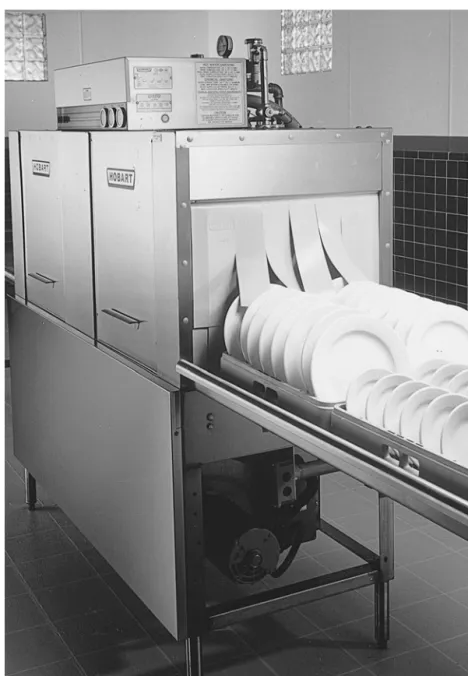
FACILITIES CLEANING AND MAINTENANCE
Thermometers that record the temperatures of both wash and rinse water and thermostatic controls are included as standard parts of dishwashers. Booster heaters with temperature controls are available and necessary to provide the disinfection flush temperature because the water at 180°F in the piping of a building would pose a personal safety hazard.
Organization and Scheduling
In the latter, a disposal can be included as part of the dishwasher's scraping and prewash units. While the tray and guard are drying, wipe the rest of the machine with a clean washcloth, then clean.
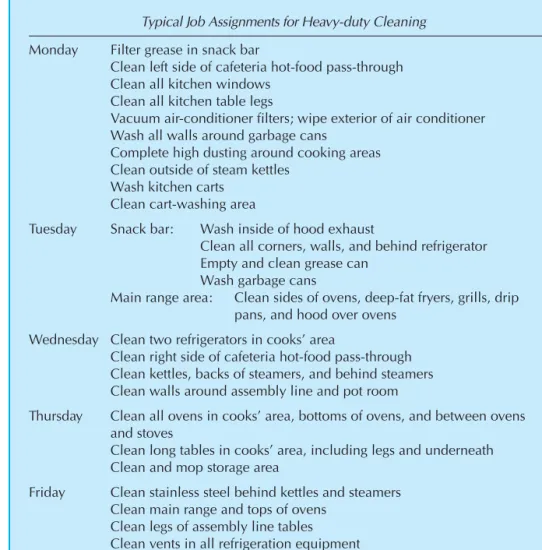
Preventive Maintenance
Dishwashers, mixers, peelers, slicers and stationary can openers are also examples of equipment that should be cleaned after each use. Detailed records of repairs and costs are kept and used to determine when a piece of equipment needs to be replaced.
Pest Control
The Food Service Manager prepares a list or file of all equipment, including the name, identification number, date of purchase, and installation and repair information for each piece of equipment. Trapping and the use of rodenticides are part of a rodent control program and are used inside or outside the building.
Checks and Inspections
However, the most effective rodenticides are also the most dangerous to humans and pets; therefore, they should be used with care and caution. The effectiveness of such an effort depends on the purpose, regularity, and intelligent administration of a cleaning program and proper care of food products to eliminate environmental factors that contribute to pest harborage.
WORKER SAFETY
Two OSHA standards of particular interest to food service operators are the Hazard Communication Standard (HCS) and the Bloodborne Pathogens. An inventory of all chemicals used in the operation must be kept and properly labeled.
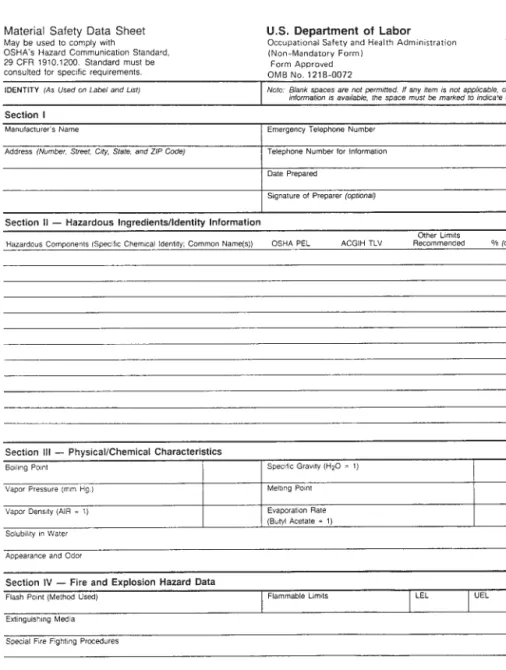
Worker Safety
Safety Program
An accident report form should be completed for every accident, no matter how minor it may seem (Figure 4.13 shows an example). It is immediately clear from this that proper training is needed to reduce accidents.
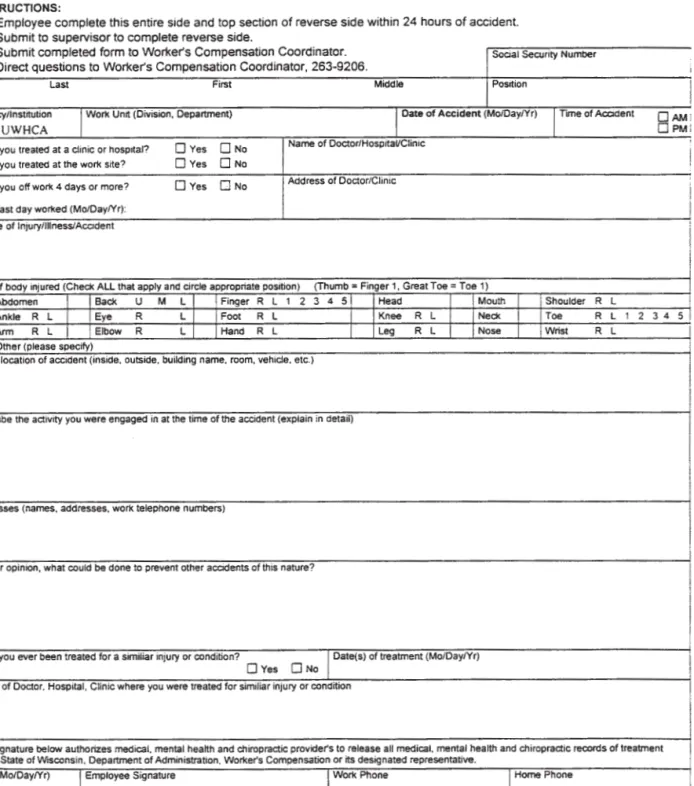
Customer Protection
What should be included in a safety training program for the employees working in the reception area. Why is it important to train employees who work in the receiving area on OSHA's Hazard Communication Standard.
THE MENU IS THE SINGLE MOST INFLUENTIAL PLAN IN A
Regardless of the type of food service organization, careful planning, implementation and evaluation of the menu is essential to the success of meeting customer needs and preferences within available resources. 9.Staff and customer acceptance of a new menu can be improved by active input during the menu planning process.
THE MENU
In a retail environment, a menu is designed to attract customers and generate sales, while on-site non-commercial operations plan menus to meet the needs and preferences of a known population. This review is followed by specific guidelines on how to write menus and includes step-by-step procedures to ensure the menu process is completed on time.
THE SYSTEMS APPROACH TO MENU PLANNING AND MAINTENANCE
The collection of all menus for a particular food service operation is referred to as the master menu and is used to manage the entire food service: front and back of house.
TYPES OF MENUS
Whatever the length of the cycle, the menus must be carefully planned and evaluated after each use. A limited or semi-selective menu allows one or more choices in some of the menu categories.
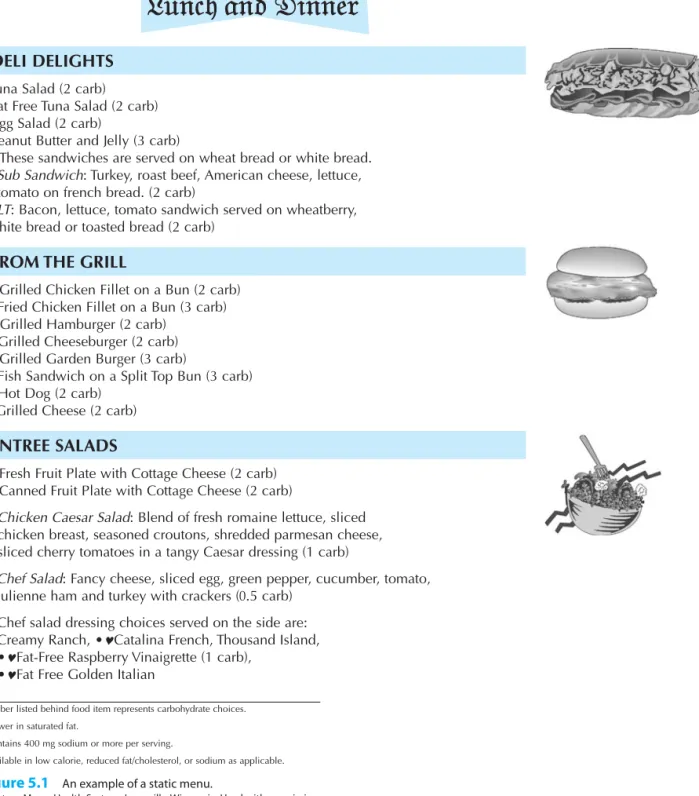
Meal Plans and Menu Patterns
The table d'hôte menu offers a complete meal for a fixed price, while the du jour menu refers to the menu of the day. Organizations that use the non-selective menu usually have a list of alternatives to offer in the event that a customer does not want any of the menu items offered.
Inspiration
Grilled tuna steak with dill sauce Chicken salad on a croissant Fresh fruit and cottage cheese plate with a muffin. Lemon-roasted fish with tartar sauce Potatoes gratin Broccoli cubes Cup of fresh fruit Roll with marg 2% milk.
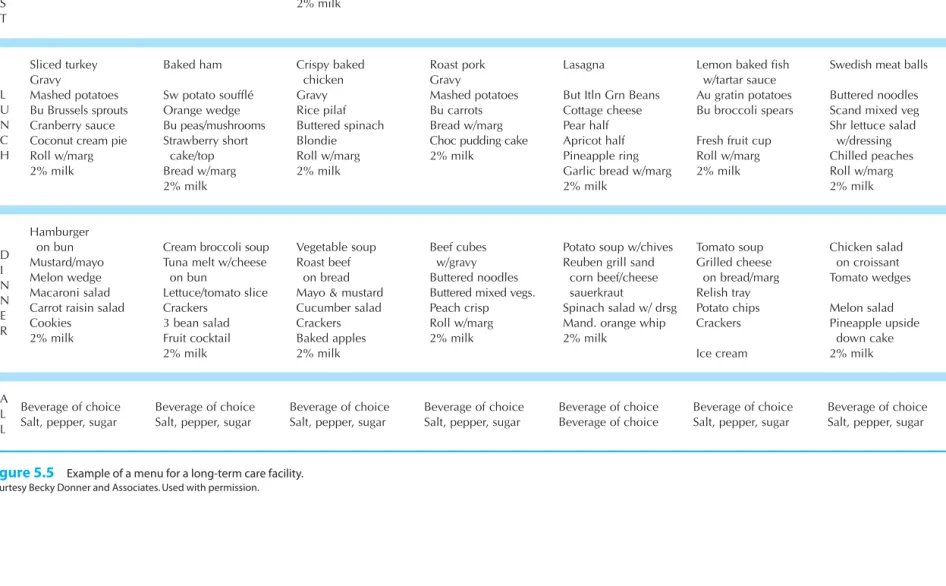
THE MENU PLANNING PROCESS
It is important for the menu planner to understand that good menu ideas can come from many different places. A creative open approach to new menu ideas and concepts will keep current and potential customers interested in the dining program.
Organizational Mission and Goals
This can sometimes present a challenge for the menu planner, especially when there is a conflict between customer preferences and the organization's mission. This conflict can be exacerbated if the catering service needs to generate enough revenue to stay in business.
The Customer
Current regulations for on-site facilities often require the RDAs (recommended daily allowances), as defined by the Food and Nutrition Board of the National Academies. In 1995, a subcommittee, referred to as "The Dietary Reference Intake Committee", announced that a panel of experts would review key nutrients and other important food components.
MEAL PATTERN FOR LUNCH—TRADITIONAL FOOD-BASED MENU PLANNING
MEAL PATTERN FOR BREAKFAST—TRADITIONAL OR ENHANCED FOOD-BASED MENU PLANNING
Eating habits are based on many factors, one of the most direct is the approach to food and eating at home. RDAs are set to meet the needs of nearly all (97 to 98 percent) of the individuals in a group.

DIETARY GUIDELINES FOR AMERICANS
Budget Guidelines
In a school, healthcare facility or other non-commercial organization, a surcharge for raw food may be determined per unit volume, such as a person, meal or day. For example, the relatively high raw food costs of fresh fish can be offset by cheap ground beef products.
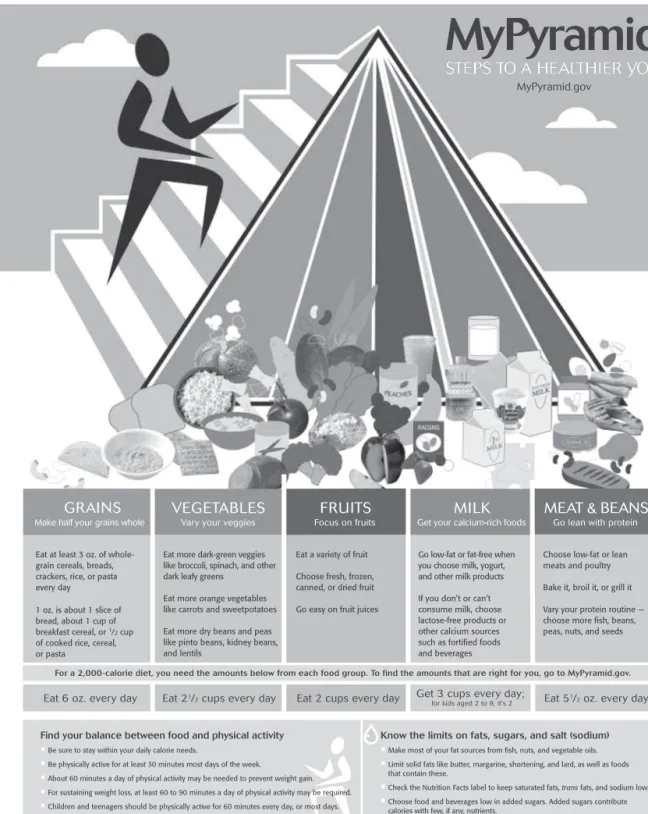
Production and Service Capabilities
Depending on the geographic location of the food service, a source of sufficient inventory may be difficult to secure. Style of service affects the choice of food items and the number of choices on the menu.
MENU DEVELOPMENT
The dynamics of the markets or food sources can have a limiting effect on the menu, although this is less of an issue in today's global market economy. If the food is prepared in a central kitchen and sent to service areas in remote locations, the menu planner must consider what the quality of the product will be by the time it reaches the final service point.
Timetable for Planning, Development, and Implementation
Knowledge of fruits and vegetables and their seasons allows a planner to include them on the menu while they are at their peak of quality and at an affordable price. Regardless of whether the menu planner is responsible for purchasing the food, he or she must keep abreast of new items on the market and be aware of foods that may add interest to the menu or the variety and quality of menu items offered. improve.
Steps in Menu Development
BBQ Ribs Sliced pineapple Pasta #1 with Spaghetti Chocolate toffee cookies Tartar sauce Sliced Cajun Turkey breast Assorted whole fruit Potato: Mashed with sauce Lemons. Sloppy Joes Sunshine blend Pasta #21 with Farfalle Chocolate cake Turkey and gravy Assorted whole fruit Mashed potatoes.
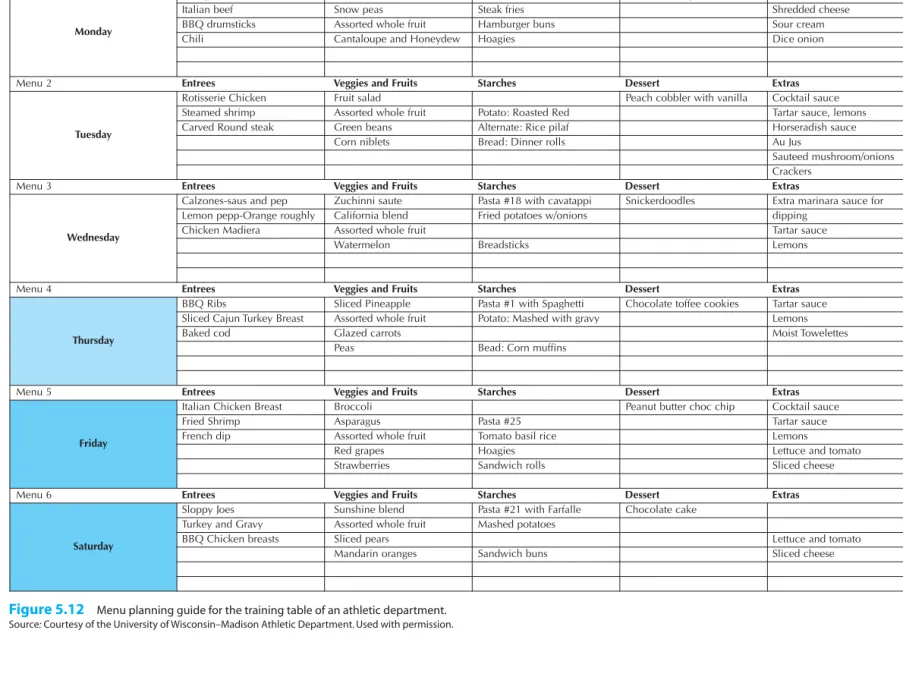
Food Characteristics and Combinations
In a selective menu, the number of choices can be limited to two or three plus a daily offering of fruit, ice cream or sorbet and yogurt. For a commercial cafe, the selection of desserts can be quite extensive and include a two-crust pie, a cream pie, cake or cookie, pudding, fruit, ice cream or sorbet, and gelatin dessert.
Menu Evaluation
Once it is determined that a menu item might appeal to a customer base, it is wise to test the product before adding it to the menu and implementing it into the system. This gives the manager a chance to test the product with customers before officially adding it to the menus.
Writing Menus for Modified Diets
Are the seasonal products offered available and within an acceptable price range? For example, the University of Wisconsin-Madison's food service division conducts new menu item tests twice a month.
RECIPE TESTING
FOOD ITEM
COMMENTS
THE POSTED MENU
Menu Design and Format
- PART 3
- Purchasing
- Receiving, Storage, and Inventory
- Production
- Service
- CHAPTER 6
How would you decide if a menu item is popular enough to stay on the menu. How can the season of the year affect when each of these items is placed on the menu.
PURCHASING IS AN ESSENTIAL FUNCTION IN A FOOD-
In this chapter, approaches to the selection of suppliers, the determination of food needs and the writing of specifications are discussed, as well as the methods of purchase. 4. Markets and the function of purchasing are regulated at the federal, state and local level.
WHAT IS PURCHASING?
5. A buyer is a member of the professional administrative team and is held to high standards of job performance and ethical conduct. 10. Procedures used to purchase products vary depending on the formality of the purchasing function.
THE MARKET
The commodity and the regions in which it is grown are collectively called the primary market. A market can also refer to a collection of activities that result in the transfer of ownership of food from the producer to the consumer.
Market Distribution
Understanding the Market
This agency is responsible for the inspection of certain shellfish and advises state and local governments on sanitary standards for the production, processing and distribution of milk. The Bureau of Alcohol, Tobacco, Firearms and Explosives (ATF) in the Treasury Department is responsible for monitoring the production, distribution and labeling of alcoholic beverages.
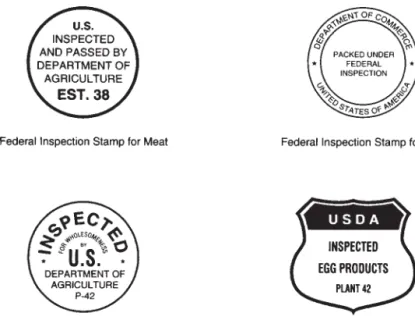
THE BUYER
Purchasing the quantity and quality of food required for the food service within the constraints imposed by the budget and financial policy of the organization requires knowledge of internal and external factors. There must be a clear understanding of the buyer's decision-making authority and of the institutional policy within which the buyer must operate.
The Art of Negotiation
External factors include the marketing system, food standards and quality, product availability and purchasing methods. The buyer represents the institution in negotiations with market representatives and must have extensive knowledge and understanding of the legal requirements, especially as they relate to orders and contracts.
Ethics in Purchasing
Internal factors include the customers, the menus, recipes, labor availability and skills, equipment, storage facilities, and amounts of food required.
Structure of Purchasing
The GPO is an organization that represents member organizations and oversees the purchasing function for the entire organization. The advantage of these connections is the overall cost savings for the organization and not for individual units.
VENDORS AND FOOD DISTRIBUTORS
A key responsibility of the buyer in beginning a professional working relationship with a seller is to carefully evaluate the seller's scope of products and services. Location and size of the food service are important factors in choosing a supplier.
Informal or Open-Market Buying
The two main purchasing methods are informal or open market purchasing and formal competitive bidding. The purchasing methods chosen depend on these institutional policies, the size of the organization, the amount of money available, the location of the vendors, and the frequency of deliveries.
Purchase Order
Health UW University of Wisconsin
Unauthorized
Many variations and techniques are found in formal competitive bidding, depending on the type of institution, financial resources of both seller and buyer, and storage facilities of the food service and delivery capabilities of the seller. Another variation involves purchasing a specific amount of merchandise, such as a year's supply of canned goods, but due to insufficient storage, the food service can arrange to draw on the contract during the duration of the contract period.
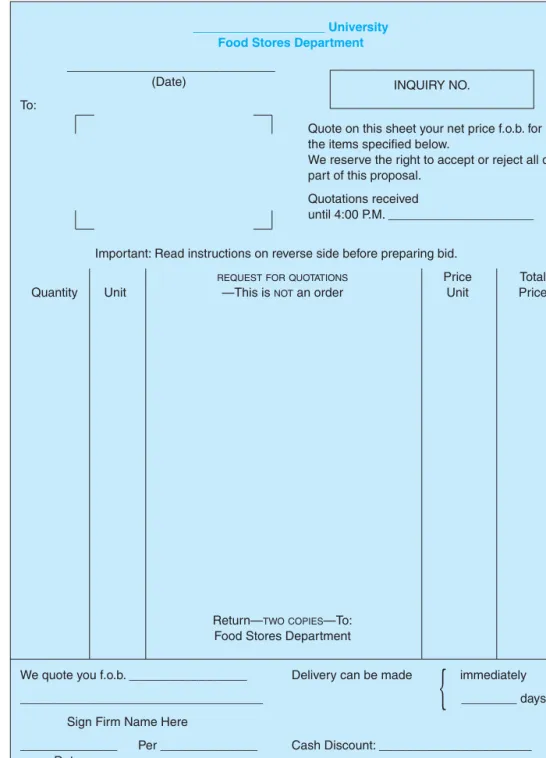
Variations on Methods of Purchasing
In a firm fixed price (FFP) contract, the price is not subject to adjustment during the contract period, which places maximum risk on the seller and is used when certain specifications exist and fair and reasonable prices can be set at the outset. Attached to the invitation is a list of the goods needed, the specifications and quantities involved, as well as any conditions related to supply and market fluctuations.
PRODUCT SELECTION
A BPA must be established with more than one vendor so that delivery orders can be placed with the company offering the best price. Using more than one seller also allows the buyer to identify the "price creep" that can occur when only one seller is involved.
Market Forms of Foods
In fact, it is an inventory and production planning strategy where product is purchased in the exact quantities required for a specific production period and delivered "just in time" to meet production demand. There may be times when a menu change needs to be made due to the price difference between fresh, frozen and canned foods.
Food Quality
Quality classes are assigned according to marbling, maturity of the animal and color, firmness and muscle structure. Because of the wide variation in quality and the perishable nature of fresh fruits and vegetables, visual inspection can be as important as grade; or a buyer may specify that the condition of the product at the time of delivery must equal the grade required.
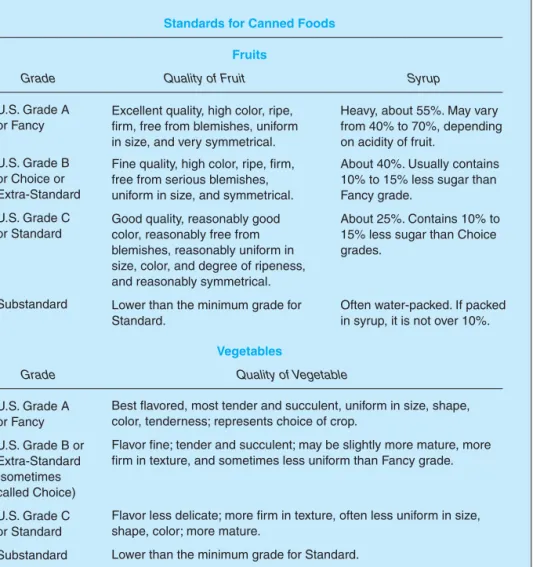
PURCHASING PROCEDURES
USDA grades are used for most fresh meats and for fresh fruits and vegetables, but very few canneries use them, preferring to develop their own brands. If USDA grades are specified and bidders quote prices for branded products, the buyer must be familiar with USDA grades and ratings in order to evaluate the products.
Identifying Needs
Each time an order is placed, the stock is brought to this level, regardless of the stock at the time of the order. Some products, such as milk and bread, are delivered daily or several times a week, and orders are based on the quantity needed to maintain stock.
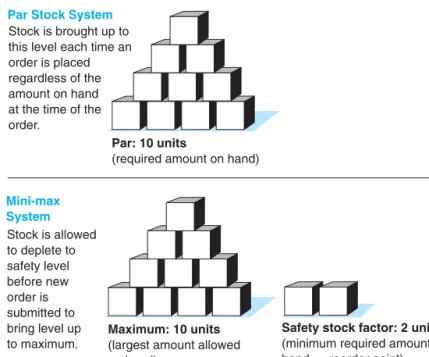
Specifications
4 peas; apricot halves in heavy syrup or 21 to 25 degrees brix (syrup density); diced beets, drained weight 72 ounces (per No. 10 can); or tomato catsup with a total solids content of at least 33 percent. Frozen foods: Variety, sugar ratio, temperature during delivery and upon receipt; for example, sliced strawberries, sugar ratio of 4:1 or delivered frozen, 0°F or less.
Issuing Bid Requests
This is especially important when dealing with large quantities and is often requested when purchasing canned food. Canned food testing is done by "cutting cans," which involves opening the sample cans and rating the products based on USDA scoring factors.
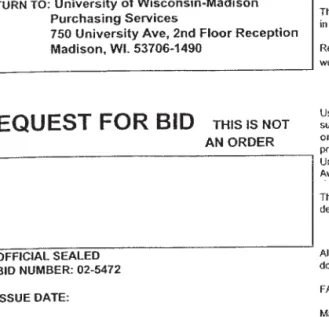
Developing Purchase Orders


